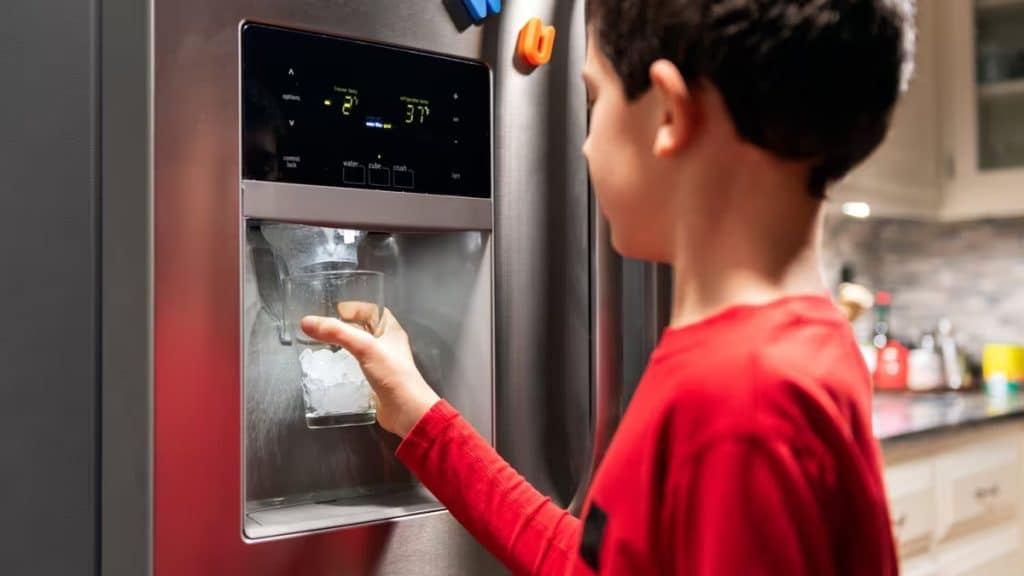When the Ice Maker Stops Making Ice
It’s a perplexing situation when your ice maker suddenly halts ice production. The reasons could be diverse:
- A kinked water line impedes water flow.
- A filter might be clogged.
- A water valve isn’t opening correctly.
The thoughtful homeowner starts by ensuring the water supply connection is secure and checking that the filter isn’t overdue for a replacement. Remember that freezer temperature settings are critical; your ice maker can’t do its job if the environment isn’t cold enough. It should be set between 0 and 5 degrees Fahrenheit for optimal ice production, and a freezer thermometer can help keep things in check. Also, be aware of the fill tube: if it’s frozen, it must be thawed to resume regular operation.
Diagnosing Ice Maker Issues
A refrigerator with a built-in ice maker can be a substantial convenience until it stops functioning correctly. Diagnosing issues with ice makers starts with observing the symptoms. For instance, an ice maker not producing ice can indicate water supply problems, while small or misshapen cubes suggest temperature inconsistencies. Listening to unusual noises that could indicate mechanical failures within the ice-making mechanism is crucial. You’ll want to investigate for any apparent signs of wear and tear or leaks, which could point to a specific part needing replacement. If you need help figuring out where to start, Part Select offers a wealth of information on common ice maker problems to help you begin your troubleshooting journey.
Ice Maker Produces Odd Tasting Ice
When your ice tastes unusual or carries a distinct odor, it might raise some eyebrows. This problem often arises from contaminants or stale, trapped odors within your freezer. Food particles can seep into the ice-making cycle, imparting unwanted flavors. The potential for this issue increases if the water filter is aging and failing to cleanse impurities from the water efficiently. It’s important to promptly address changes in ice taste or smell to prevent adverse health effects and ensure your beverages remain untainted. Consult your manufacturer’s recommendations on water filter replacement intervals to maintain the highest quality ice. In addition, it’s worth emptying the ice bin occasionally, washing it thoroughly, and starting fresh to prevent any mustiness.
Slow Ice Production and Solutions
Slow ice production can evolve from a minor inconvenience to a source of frustration, especially when you need ice on demand. Before venturing into more complex solutions, assess the most straightforward fixes: confirm that the freezer temperature is set appropriately and that the ice bin isn’t overfilled. Overfilling can sometimes interfere with sensors and halt the production cycle prematurely. If the freezer thermostat malfunctions, it might incorrectly gauge the temperature, causing the ice maker to slow down. A full defrost of your freezer and ice maker unit can sometimes jump-start production, as frost buildup can interfere with mechanisms. Remember, a clean machine is a happy machine! Regularly wiping down the inside of your freezer and ice maker can aid in maintaining optimal performance.
Preventive Maintenance for Ice Makers
They say an ounce of prevention is worth a pound of cure, and that sentiment holds regarding ice makers. Routine maintenance not only prolongs the life of your appliance but also forestalls common issues. Check the condenser coils and ensure they’re free of dust and debris, which can impede heat dissipation. A clean water filter is essential, so replace it according to the manufacturer’s schedule to prevent scale buildup and contaminants. And don’t forget general hygiene—clean the ice bin regularly with a gentle detergent and warm water. Need more information on upkeep? Engage with expert guidelines from Consumer Reports, which offers comprehensive advice on refrigerator maintenance, including the ice-making component.
When It’s Time to Call a Professional
While it’s empowering to tackle at-home repairs, recognizing the limits of DIY is essential. If you’ve exhausted all troubleshooting steps and the problem persists, it’s prudent to involve a certified appliance repair technician. This is especially true when dealing with intricate parts such as the electronic control board or potential refrigerant issues requiring specialized knowledge and tools. A professional approach ensures a proper diagnosis and mitigates the risk of causing further damage or voiding warranties. Expert intervention can save time and money in complex situations while providing peace of mind.
Advancements in Ice Maker Technology
The ice maker industry is not static; it benefits from continual technological advancements that enhance functionality and user experience. Modern units may feature energy-efficient cycles to reduce utility costs, intelligent sensors that prevent overflow, and innovative freezing techniques to create better-quality ice. Some are Wi-Fi enabled, allowing users to monitor and control their ice makers through smartphone apps. Whether you’re in the market for a new refrigerator or curious about how today’s appliances are evolving, keeping current with the latest developments can be eye-opening. This can include learning about cutting-edge features that could be the deciding factor in your next purchase. To dive deeper into what’s new in ice maker technology, reading articles like those from Science Daily can be immensely useful.
Conclusion: Ensuring Continuous Ice Supply
In the heat of summer or when hosting gatherings, an uninterrupted ice supply is more than just a luxury—it’s essential. Knowing common pitfalls and their solutions, you can keep your ice maker humming efficiently. It’s crucial never to overlook the benefits of regular maintenance and equally vital to appreciate modern appliance technologies’ convenience. Should your ice adventures enter turbulent waters, remember that professionals are just a call away, ready to return your ice-making harmony. Ultimately, taking care of your ice maker is integral to enjoying the relaxed, refreshing luxury of on-demand ice whenever needed.
